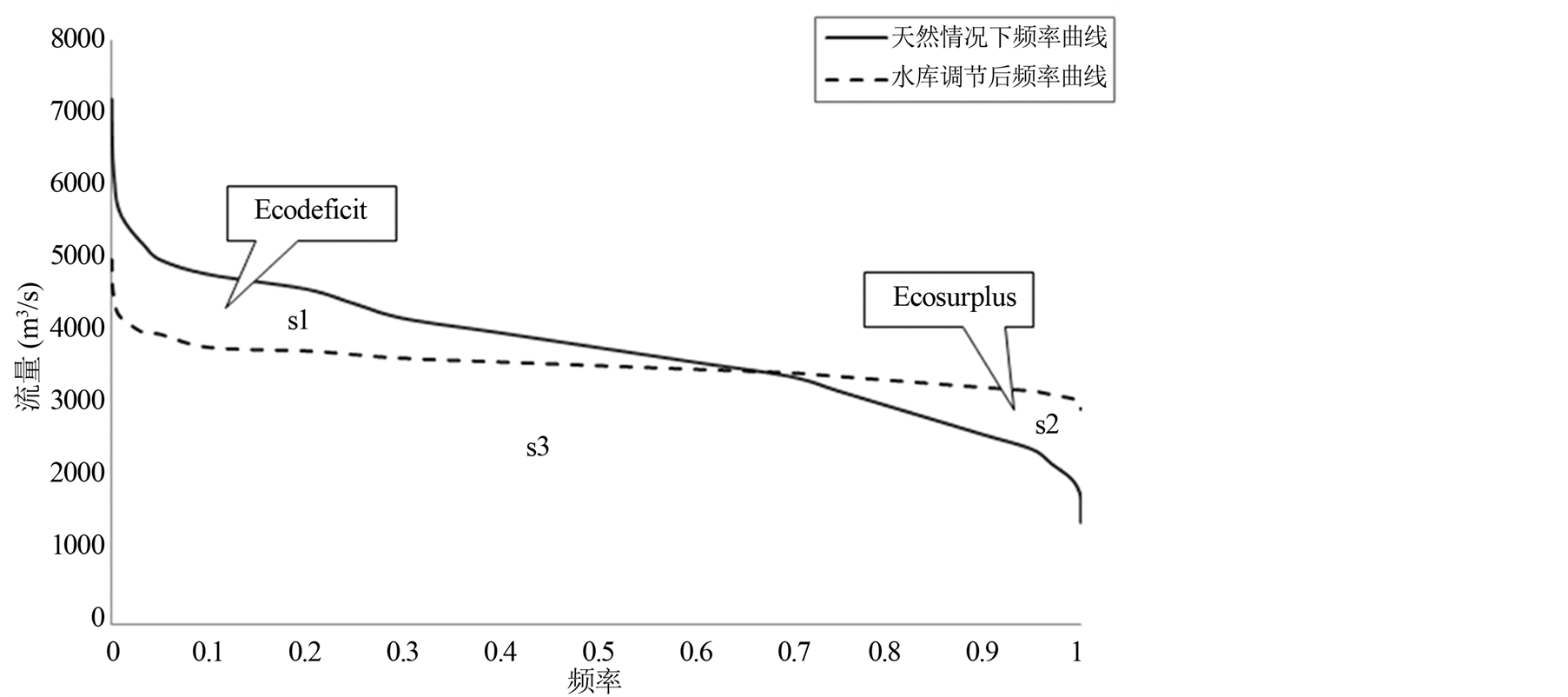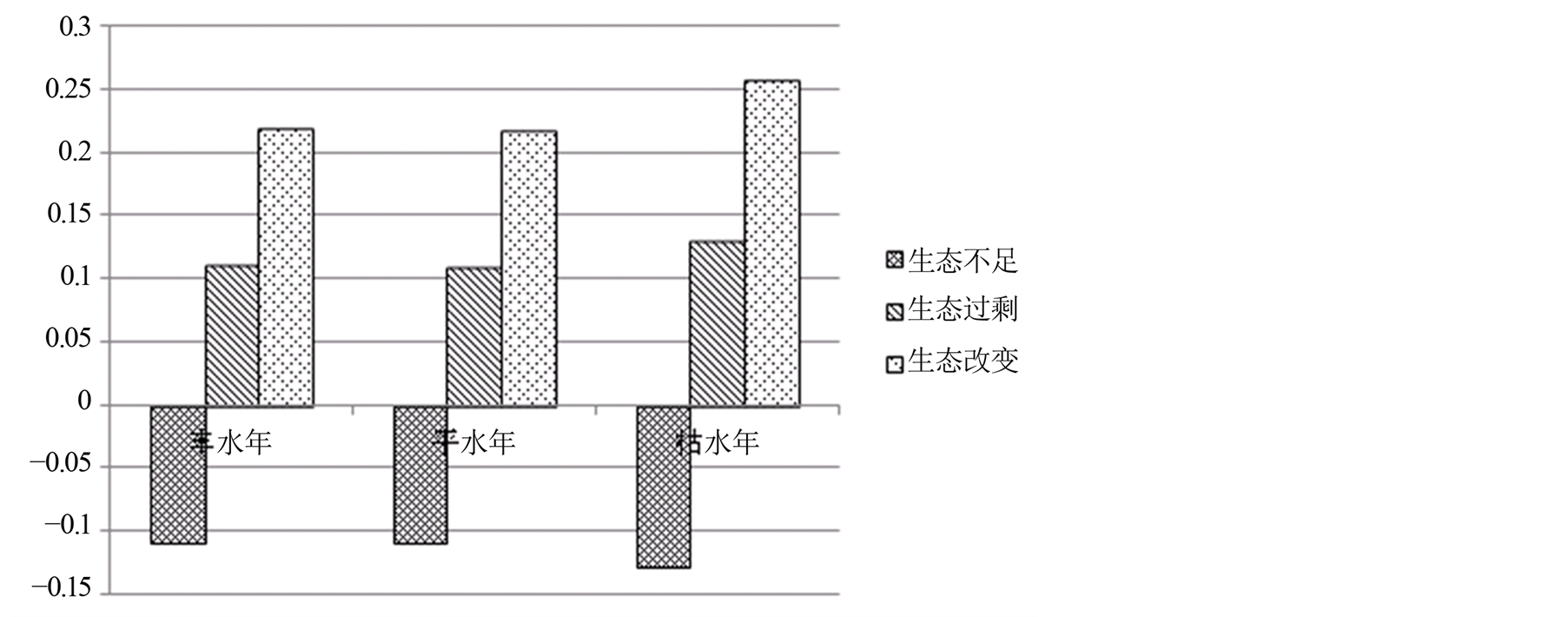1. 引言
为刻画河流水文情势特征和评价水文变化,自上世纪90年代起,国内外学者提出了多种量化水文过程的水文指标体系,如美国Richter等[1] 提出的5类33个水文变化指标(Indicators of Hydrologic Alteration, IHA),澳大利亚Crowns等[2] 提出的7类91个指标,张洪波等[3] 提出包含7类50个生态水文指标的黄河生态水文指标体系。此外,Olden等[4] 在总结已有171个水文指标基础上,对这些指标进行冗余分析,研究表明IHA指标基本能反映171个生态水文指标的信息,加上其内嵌RVA方法开发出相应的应用软件(Richter et al., 1997),被广泛用于评价人类活动(如建坝、引调水等)引起的河流水文变化。但随后Gao等[5] 研究表明,IHA等水文指标存在内部联系,会造成信息冗余,并期望能用少数关键指标描述水文情势的主要变化特征,以最小化信息冗余,并减少水库生态调度或其他调控措施设计的复杂性。为此,Vogel等[6] 基于流量历时曲线提出一种无量纲的生态流量指标评价水文情势的变化,减少了水文情势的评价指标。Gao等[7] 也利用生态流量指标并结合降水距平,研究降水和水文情势改变之间的关系,并分析水文变化指标IHA和生态流量指标之间的关系,认为生态流量指标和IHA指标具有一定的相关性,可以相互补充使用。生态流量指标(Eco-flow metrics)分为Ecodeficit和Ecosurplus,分别描述影响后的流量相对影响前出现的不足和过剩情况,相对比于其他水文指标,生态流量指标不要求历史流量资料的连续性,避免了因流量数据缺失而进行插补所带来的误差,同时指标的数量更少,不存在指标之间的信息冗余,能够更加合理的指示水文情势的变化,为水库的生态调度提供依据。
金沙江上游水能资源丰富,自2005年金沙江下游四个梯级水电站—向家坝、溪洛渡、白鹤滩、乌东德相继开工建成,大坝修建后,随着水电站开始相继运行,距离向家坝坝址只有1.8 km的长江上游珍稀特有鱼类国家级保护区的水文情势势必会发生变化。因此有必要研究金沙江梯级水库调度运行对下游水文情势的影响程度从而有助于协调河流水电开发利用和生态环境保护关系。本文采用基于流量历时曲线的生态流量指标方法分析金沙江下游梯级水库四库联合模拟调度运行在长系列、丰平枯水平年以及自然四季中对生态水文过程的影响程度大小,旨在以少量的参数指标,更加合理简练地分析水文情势的变化情况,为梯级水库生态调度研究提供参考依据。
2. 数据与方法
2.1. 数据来源
为评价金沙江梯级水库运行调度对坝下水文情势的影响,采用位于向家坝坝下的屏山水文站1951~ 2011年的实测逐日数据,并通过建立金沙江下游梯级水库联合调度模型,以屏山站1951~2011年逐日水文资料作为梯级水库调度的来水,对金沙江下游4个梯级水库进行长系列的联合优化调度,得到同样长度的调度后的向家坝水库下泄流量过程,即为屏山站调度后的水文过程(假设为2031~2091年)。对比调度前后的流量系列,分析调度对水文情势产生的影响。
2.2. 研究方法
1) 生态流量指标法
研究采用的是基于流量历时曲线的生态流量指标——Ecosurplus/Ecodeficit和基于IHA的RVA法。
对于生态流量指标,首先明确流量历时曲线的定义是在某个时段内某个流量与大于等于该流量所对应的时间之间的相关关系,然后根据其的定义,分别计算水库调度前后的水文要素统计特征,绘制频率曲线图。以水库调度前的频率曲线为基准,当水库调度后的水文要素频率曲线位于调度前的频率曲线之下时,两条频率曲线之间的面积占水库调节前频率曲线的投影到频率横坐标的面积的比值称为Ecodeficit,即生态不足,该值代表的意义为该水文要素低于河流生态系统对该要素的需求值。反之,当水库调度后的水文要素频率曲线位于调节前的频率曲线之上时,两条频率曲线之间的面积占水库调度前频率曲线的投影到频率横坐标的面积的比值称为Ecosurplus,即生态过剩,该值代表的意义为该水文要素超过河流生态系统对该要素的需求值,如图1所示,两者之和称为Ecochange,即生态变化总值,表示整个时间段之内的水文变化情况[8] 。采用的时间段不同,生态不足和生态过剩两项指标代表的时间范围不同。

Figure 1. The definition of eco-flow metrics
注:Ecochange = Ecodeficit + Ecosurplus,其中Ecosurplus = S2/(S1 + S3),Ecodeficit = S1/(S1 + S3),S代表该区域的面积。
图1. 生态流量指标定义
2) 变动范围法
RVA方法是将水文系列划分为影响前和影响后两个部分,用影响前的水文系列建立每个IHA指标的变动目标范围,如一般采用25%~75%的频率区间作为目标范围,若影响后水文系列的某个IHA指标落入目标区间的频率低于或超出50%,则说明水文系列的针对该IHA指标的水文特征发生了变化。水文变化度的计算公式为
 (1)
(1)
 (2)
(2)
式中:Di为第i个IHA指标的变化度;N0,i为影响后水文系列IHA指标值落入RVA目标范围内的年数;Ne为影响后IHA指标值落入RVA目标范围内的期望年数;r为影响前IHA指标落入目标范围内的年数的比例,对于25%~75%频率区间的目标范围,r = 50%;NT为影响后水文系列的总年数,一般要求大于20年。为评价总体水文变化程度,将32个IHA指标的水文变化度进行加权平均,得到综合水文变化度[9] 。
3. 结果与讨论
本文以屏山站水文站1951~2011年和模拟调度后2031~2091年的日均流量为研究对象,对长系列、丰水年、平水年、枯水年4种类型进行分析,同时按自然四季建立流量历时曲线进行分析。最后为验证该结果的适用性,采用RVA法进行对比。
3.1. 水文情势年变化
根据生态流量指标的定义,以屏山站1951~2011年为梯级水库运行调度前的近自然状态河流,模拟运行后的2031~2091年的为干扰状态河流,进行对比分析,得到结果如图2和图3所示。从图2可知,对比近自然状态和模拟调度的长系列年,水文情势的变化在生态不足和生态过剩两方面的值相差不大,均为0.1左右,结合图3的流量历时曲线可知,金沙江梯级水库的调度运行后对向家坝坝下屏山站高流量的消减和低流量的提升作用较为明显,流量改变情况主要集中在5%~15%的高流量部分和30%~50%的中流量部分。

Figure 2. The change of eco-flow metrics at Pingshan hydrological station before and after the operation of cascade reservoirs
图2. 梯级水库调度运行前后屏山水文站生态流量指标变化
为更详细的分析梯级水库调度对水文情势的影响,选取丰水年、平水年、枯水年三种类型的典型年进行分析,计算结果如图4所示,生态流量指标在不同的典型年的变化趋势相差不大,和长系列得到的结论相吻合,即生态过剩情况略大于生态不足情况。
而对比丰、平、枯三种水平年的生态不足和生态过剩指标,可以发现在枯水年,生态过剩和生态不足的值均为最大,在平水年,生态过剩和生态不足最小,丰水年的生态过剩和生态不足的值介于两者之间。说明梯级水库的调度运行产生的生态不足和生态过剩的影响大小依次为枯水年、丰水年、平水年。对比丰、平、枯水年的生态变化总值,枯水年的变化最大,丰水年次之,平水年影响相对最小。
综上所述,水库调度对枯水年的影响最大,且主要体现在对生态过剩情况的影响,对平水年的影响在两方面均最小,究其原因可能是水库调度蓄丰补枯的运行方式相关,且水库调节库容与枯水期径流量的比例远高于与丰水期的径流量比例,从而造成水库运行对枯水期流量的影响要明显高于丰水期流量的影响。

Figure 3. The flow duration curve of Pingshan hydrological station before and after the operation of cascade reservoirs
图3. 金沙江梯级水库模拟调度前后屏山水文站流量历时曲线

Figure 4. The change of eco-flow metrics at Pingshan hydrological station during wet, normal and dry years
图4. 丰水年、平水年和枯水年生态流量指标变化
3.2. 水文情势季节变化
对比屏山水文站实测水文资料和通过模拟调度得到的水文资料,得到梯级水库调度前后四季(3~5月为春季,6~8月为夏季,9~11月为秋季,12~2月为冬季)生态流量指标变化情况如图5所示。从图5分析结果来看,春季的生态过剩指标值最大,为0.816,远远超过其他三个季节的生态过剩指标。其他三季中,夏季的生态过剩指标值为0.072,秋季的生态过剩指标为0,冬季的则为0.044,说明梯级水库的调度运行在夏、秋、冬三季对流量的增加情况不明显,而在春季,梯级水库调度产生的影响全部体现在生态过剩情况上,说明调度在枯水期对流量的提升作用较为明显。另从春夏秋冬四季生态过剩指标的数值变化情况上分析得出,生态过剩指标的变化呈现周期性变化,即春季最大,夏季递减,秋季为零,冬季又增加,依次循环。
同理,对比生态不足指标,春季的值的大小为0,夏季的值的大小为0.084,秋季的值最大,为0.207,冬季的值和春季的同为0。从分析结果可以看出,梯级水库的调度运行对高流量的削弱较为明显,体现在夏季的生态不足的值小于生态过剩的值,秋季的影响全部体现在生态不足之上,其原因可能是水库的蓄水作用使得下泄的水量有所减少。且从生态不足的数值变化情况上分析得出如生态过剩指标相似的周期规律,即春季最小,夏季递增,秋季最大,冬季又最小。
总结上述分析,对比春夏秋冬四季的生态流量指标变化情况可知,水库调度对春季的影响最严重,秋季次之,冬季相对最小。
3.3. RVA检验
为验证上述结果的可靠性,本文采用运用较为广泛的基于IHA的RVA法进行验证。对屏山水文站在模拟调度前后的日均流量数据进行相关计算,得到屏山站的综合水文变化度D0 = 56.47%,属于中度变化,计算结果如表1所示。

Figure 5. The change of eco-flow metrics at Pingshan hydrological station in different seasons
图5. 屏山站模拟调度前后自然四季生态流量指标变化

Table 1. The whole hydrologic alteration at Pingshan hydrological station
表1. 屏山站水文情势的综合改变度
从表1中可知,水文情势变化主要集中在第五组指标(水文条件改变的变化和频率)、第三组指标(年极值水文状况出现时间)和第一组指标(月流量)三组指标之上,结果表明水文情势的变化对流量的变化频率和极值出现时间影响较大,这是采用生态流量指标法得到流量变化体现在极值流量的结论相符,说明在整体分析水文情势的变化上,两者之间具有一定的相似度。
另外,从上述关于季节变化的分析结果得出,春季的流量改变程度最大,且主要体在生态过剩之上,这与表2中屏山站水文情势属于高度变化的指标中包括3~6月平均流量,且变化趋势为流量增加相符合。
从上述分析可知,生态流量指标分析水文情势变化和采用基于IHA指标的RVA法分析得到的结果具有一定的相关性。从长系列分析、典型年分析、自然四季分析的结果和IHA分析得到的结果分析得出运用生态流量指标在屏山水文站水文情势变化分析中能够得到大部分主要信息。相比IHA得到的水文情势变化结果,生态流量指标可以更好了分析丰平枯典型年以及自然四季等不同时间段的水文情势变化特征,所以把生态流量指标和IHA指标相结合对水文情势进行分析,能够更好的分析水文情势变化特征,同时为水库的生态调度提供更好的依据。
4. 结论
本文利用屏山水文站长系列数据及金沙江下游向家坝、溪洛渡、白鹤滩、乌东德四个梯级水库联合模拟调度的数据,采用基于流量历时曲线的生态流量指标分析法,对比梯级水库模拟调度前后流量的变化特征,分析梯级水库在长系列、丰平枯典型年以及自然四季中对生态水文过程的影响,同时对比采用IHA法分析得到的水文情势变化结果,得出以下主要结论:
1) 生态流量指标能够分析所有年、丰平枯典型年以及自然四季的水文情势变化,采用IHA指标可以得到详细的水文情势变化特征。两者结合进行水文情势分析,可以得出更加详细准确的水文情势变化特征。
2) 基于流量历时曲线的生态流量指标具有流量历时曲线特点,如不要求历史流量资料的连续性,避免了因流量数据缺失而进行插补所带来的误差,而且能够更好地反映了径流年际、年内分布的不均匀性等。另外生态流量指标包含的指标数目较IHA指标更少,选择性更大。
3) 梯级水库调度后水文情势变化主要体现在低流量之上。春季流量、枯水年流量变化显著,春季流量变化明显高于夏、春、秋三季流量变化,枯水年流量变化也高于丰、平水年。

Table 2. The high hydrologic alteration at Pingshan hydrological station
表2. 屏山站高度变化分析
注:水文变化度 > 66.7%,为高度变化(H)。
4) 金沙江梯级水库的调度运行在一定程度在会改变了大坝上下游的水文情势,水文情势的变化又会影响到长江中下游河道的生态系统。在发挥考虑梯级水库防洪、发电、灌溉、航运等经济效益的同时,应考虑水库调度对下游生态环境的影响。

NOTES
作者简介:李杰(1989-),男,湖北安陆人,硕士研究生,主要研究方向生态水文。